List 11
1.Gentiana asclepiadea
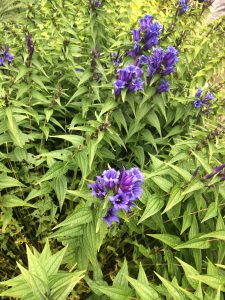
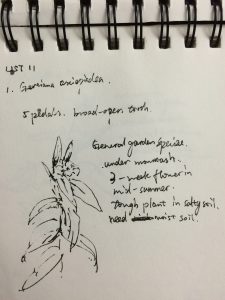
Common name: willow gentian
family name: Gentianaceae
USDA Hardiness Zone: 4-8
Mature height and spread:
height: 0.5-1m
spread: 0,1-0,5feet
Form: showy, trumpet or salver-shaped flowers
Water use: medium
Soil requirements: moistsoil
Flower/Cone/Fruit description:an herbaceous perennial to 1m, with arching stems bearing lanceolate leaves, and trumpet-shaped deep blue flowers 4-5cm in length in the upper leaf axils in late summer and early autumn. Tough plant in salty soil. showy, trumpet or salver-shaped flowers
suitable uses:general garden species, Flower borders and beds Cut Flowers Underplanting of Roses and Shrubs Cottage & Informal Garden Rock Garden
2.Hesperantha coccinea
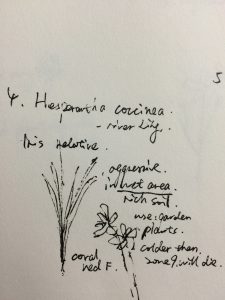
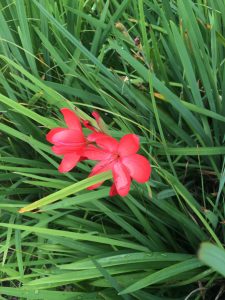
Common name: river lily
family name: Iridaceae
USDA Hardiness Zone: 7-9
Mature height and spread:
height: 1-2 f
spread: 0.75-1.5 f
Form: clump-forming
Water use: net allow dry
Soil requirements: in wet area with rich soil
Flower/Cone/Fruit description: Outward-facing, six-petaled, cup-shaped, scarlet flowers (each to 2 1/2″ wide) bloom from late summer to fall on leafless, gladiolus-like, one-sided spikes (to 2′ tall) which rise from a clump of narrow linear grass-like basal leaves (to 18″ long). Each flower spike contains 4-14 flowers. In warm winter climates, bloom may continue into winter with foliage remaining essentially evergreen.
suitable uses:Sunny borders, garden plants
3.Helianthus annuus
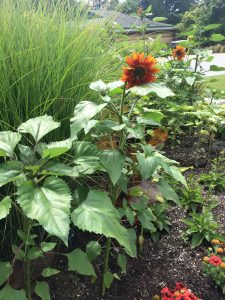
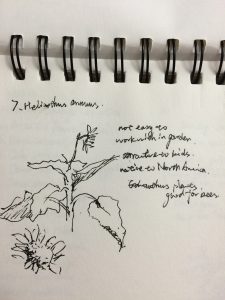
Common name: annual sunflower
family name: Asteraceae
USDA Hardiness Zone: 2-11
Mature height and spread:
height: 3-10 f
spread: 1.5-3 f
Form: coarse, hairy, leafy, fast-growing
Water use: medium
Soil requirements: average, moist, well-drained soils, tolerant to poor soil
Flower/Cone/Fruit description: It is a coarse, hairy, leafy, fast-growing annual that typically grows 5-10’ tall on stiff upright stalks. The species is a somewhat weedy plant that is now commonly seen growing along roads, fences, fields and in waste areas west of the Mississippi River and is the state flower of Kansas. It is native to Missouri, primarily in the northern part of the State. Species plants feature 3-6” wide sunflowers with orange-yellow rays and brown to purple center disks. Flowers bloom in summer. Extensive crossing and hybridizing have resulted in a large number of cultivars that greatly expand the range of flower colors (ray flowers in bright and pastel shades of yellow, red, mahogany, bronze, white and bicolors) and flower head shapes (short rays, long rays, some doubles). Dwarf varieties (1-3’ tall) and mammoth varieties (to 15’ tall) are also available. Flower heads on mammoth varieties can reach 12” in diameter. Disk flowers give way to the familiar sunflower seeds. Large, ovate to triangular, sandpapery leaves to 12” long.
Limitation:Rust, leaf fungal spots and powdery mildew are somewhat common. Caterpillars and beetles often chew on the foliage. Larger varieties often need staking, particularly if grown in exposed locations.
suitable uses:Specimen or mass. Borders, cottage gardens, bird gardens, wildflower or native plant gardens. Large varieties for border rears or backgrounds. Dwarf varieties for beds, border fronts or containers.Attractive to kids
4.Astilbe chinensis
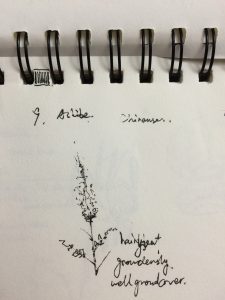
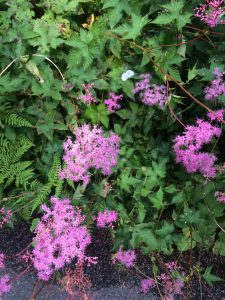
Common name: Chinese astilbe
family name: Saxifragaceae
USDA Hardiness Zone: 4-8
Mature height and spread:
height: 1-1,5 f
spread: 1-1.5 f
Form: clump-forming perennials
Water use: medium
Soil requirements: average, medium moisture, well-drained soils
Flower/Cone/Fruit description: clump-forming perennials which feature graceful, fern-like mounds of mostly basal, 2-3 ternately compound leaves, usually with sharply-toothed leaflets, and tiny flowers densely packed into erect to arching, plume-like flower panicles rising above the foliage on slender, upright stems. Chinese astilbes are slowly spreading, rhizomatous plants which bloom later than the Arendsii hybrids and generally feature hairy, biserrate, elliptic-oval, 3-ternate leaflets.
Limitation:Foliage decline (leaves brown up) may occur in hot summers and/or periods of drought if soils are not kept moist. Although Chinese astilbes have better drought tolerance than most other astilbes, they still do best with uniformly moist soils.
suitable uses:Mass or group in shade gardens, woodland gardens and shaded areas of border fronts and cottage gardens. Also effective on pond or stream banks. Foundations.
List 12
1.Artemisia ‘Powis Castle’
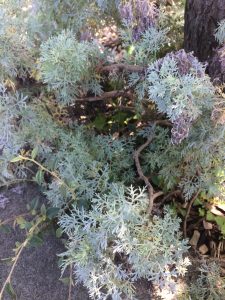
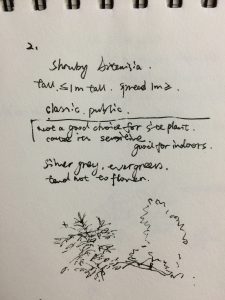
Common name: Powis Castle wormwood
family name: Asteraceae
USDA Hardiness Zone: 6-9
Mature height and spread:
height: 2-3 f
spread: 1-2 f
Form: bushy, woody-based perennial
Water use: medium
Soil requirements: average, medium moisture, well-drained soils
Flower/Cone/Fruit description: It is a bushy, woody-based perennial or subshrub that is primarily grown for its aromatic, finely-divided, silvery, fern-like foliage which is feathery in appearance. It typically grows in a shrubby mound to 2-3’ tall and as wide, but spreads by rhizomes and may reach 3-6’ wide if not restrained. Tiny yellow-tinged silver flowers rarely bloom. Plants are essentially evergreen in warm winter climates.
Limitation:Plants tend to open up in summer. Susceptible to root rot in moist soils, particularly poorly drained ones. Watch for rhizomatous spread.
suitable uses:Ground cover plant for rock gardens, retaining walls, border fronts, between stepping stones.
2.Bergenia crassifolia
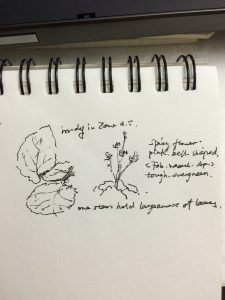
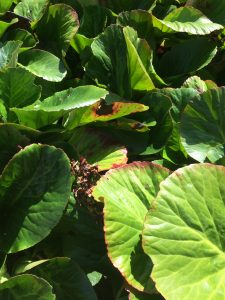
Common name: pig squeak
family name: Saxifragaceae
USDA Hardiness Zone: 4-8
Mature height and spread:
height: 1-1.5 f
spread: 0.75-1 f
Form: leather bergenia or pig squeak, is a large-leaved
Water use: medium, tolerates brief periods of drought
Soil requirements: consistently moist, organically rich, well-drained soils
Flower/Cone/Fruit description: a large-leaved evergreen perennial that is native to rocky cliffs from northwest China to Siberia. Rosettes of leathery, fine-toothed, obovate-rounded green leaves (to 8″ long by 7″ wide) form dense, slowly-spreading clumps of foliage to 12″ tall. Lavender pink flowers bloom March to early May in panicles atop rigid leafless stalks rising to 18″ tall. Flowers will bloom as early as December in warm winter climates
suitable uses:Shaded or sun-dappled areas of border fronts. Large-leaved ground cover for woodland or shade gardens. Edging for paths and walkways. Water margins. Foliage may be used in floral arrangements.
3.Phormium tenax
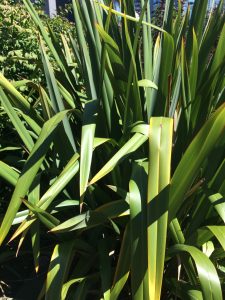
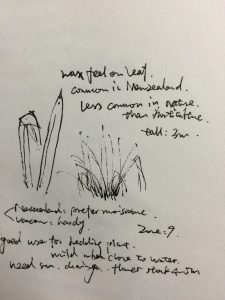
Common name: New Zealand flax
family name: Xanthorrhoeaceae
USDA Hardiness Zone: 9-11
Mature height and spread:
height: 1-6 f
spread: 1-3 f
Form: clump-forming tender perennial
Water use: medium
Soil requirements: Easily grown in average, medium, well-drained soils in full sun to part shade
Flower/Cone/Fruit description: an evergreen, clump-forming tender perennial that grown for its attractive foliage. It features rigid, sword-shaped, linear, bright green leaves (3-9’ long) in erect clumps. Leaf margins and midribs are narrowly edged with red-orange. Bronze and purple leaved varieties are available in commerce with a number of cultivars featuring variegated leaves striped or edged with pink, red, orange or purple. Leaves are creased down the middle and folded into a v-shape. Panicles of dark red flowers appear well above the foliage atop stout, rigid flowering spikes (to 12’ tall) in summer.
Limitation:Watch for mealybugs and slugs. Leaf spot may damage the foliage.
suitable uses:Sink pots to the rim in garden areas. Pots/containers for patios or decks. Greenhouse or houseplant.
4.Carex pendula
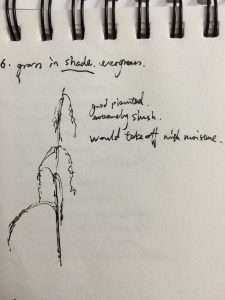

Common name: drooping sedge
family name: Cyperaceae
USDA Hardiness Zone: H4
Mature height and spread:
height: 1-1.5 m
spread: 0.5-1 m
Form: vigorous rhizomatous perennial forming
Water use: medium
Soil requirements: Easily grown in average, medium, well-drained soils in full sun to part shade
Flower/Cone/Fruit description: a vigorous rhizomatous perennial forming large clumps of dark green, linear, pleated leaves, with tall stems bearing several slender, drooping flower spikes with triangular stems bearing linear or strap-shaped leaves and short or long spikes of tiny green or brown flowers
suitable uses:good planted in extreme slush
List 13
1.Lobelia × speciosa
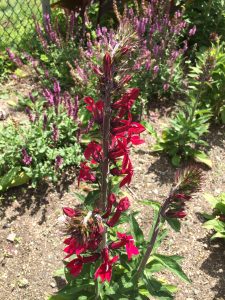
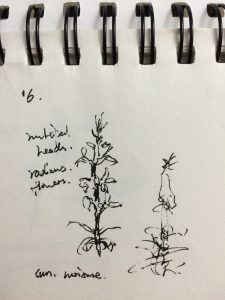
Common name: red compliment cardinal flower
family name: Campanulaceae
USDA Hardiness Zone: 5-8
Mature height and spread:
height: 1-3 f
spread: 1.5-2 f
Form: flushed with red, purple or bronze foliage
Water use: need constant moist
Soil requirements: in rich, medium to wet soils in full sun to part shade
Flower/Cone/Fruit description: attractive green foliage (often flushed with red, purple or bronze), attractive flowers (shades of lavender, pink or red) and a long summer bloom period (July to September). Plants typically grow to 2 1/2′ tall. Narrow-ovate leaves appear in a basal rosette in spring. Flower stems rise from the rosettes in July bearing showy, terminal, bracteate spikes of tubular flowers. Each flower (1-2″ long) has two lips, with the three lobes of the lower lip appearing more prominent than the two lobes of the upper lip. Hummingbirds and butterflies love the flowers.
Limitation:Snails and slugs may damage the foliage. Some hybrid lobelias have not performed well at the Kemper Center in St. Louis for reasons that at this point are unclear. L. x speciosa hybrids are often short-lived and are sometimes grown as annuals.
suitable uses:Effective in moist areas of woodland/shade gardens, wet meadows or along streams or ponds. Water gardens. Rain garden. Also adds late summer bloom and height to borders as long as soils are kept uniformly moist.
2.Humulus lupulus ‘Aureus’
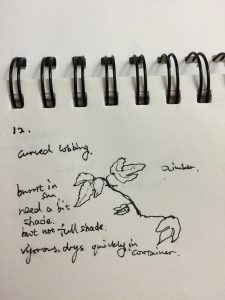
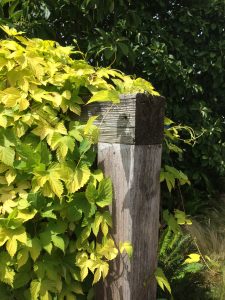
Common name: golden hops
family name: Cannabaceae
USDA Hardiness Zone: 3-8
Mature height and spread:
height: 15-25 f
spread: 3-6 f
Form: rhizomatous, twining perennial vine
Water use: medium, tolarant to drought
Soil requirements: average, medium, well-drained soil in full sun to part shade
Flower/Cone/Fruit description: is a diciduous, rhizomatous, twining perennial vine that is grown commercially for harvest of female fruits which are used by breweries to preserve and flavor beer. It is also an easy-to-grow ornamental plant that can be grown on a variety of support structures. This vine is native to Europe, southwestern Asia and North America. Hops grown commercially in the U. S. are the European variety which has now escaped cultivation and naturalized in many areas. Common hop grows rapidly each year to 15-20′ long on rough stems clad with lobed leaves. Yellow-green male flowers bloom in catkins.
Limitation: Needs a support structure on which to climb.
suitable uses:Good foliage vine for trellises and arbors. Incorporate into an herb garden. Good screen that will rapidly cover unattractive structures.
3.Agapanthus africanus
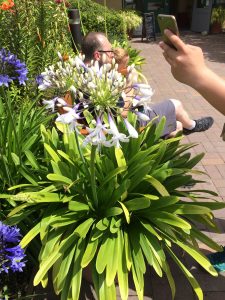
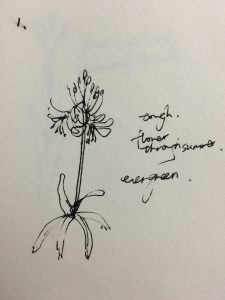
Common name: African lily
family name: Amaryllidaceae
USDA Hardiness Zone: 8-10
Mature height and spread:
height: 1.5-2 f
spread: 1.5-2 f
Form: tender perennial that grows from a fleshy-rooted rhizome
Water use: medium, tolarant to drought
Soil requirements: average, medium, well-drained soil in full sun to part shade
Flower/Cone/Fruit description: It is an evergreen species that produces rounded clusters (umbels) of blue, funnel-shaped flowers atop stiff, upright, leafless, fleshy stalks (scapes) typically rising 18-24″ tall above a dense mound of basal narrow, strap-shaped, linear, grass-like leaves. Blooms in summer. Foliage mounds are attractive when plants are not in bloom.
suitable uses:Pots, containers. Good fresh cut flower.
4.Iris domestica
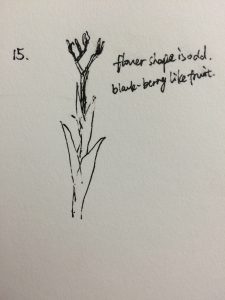
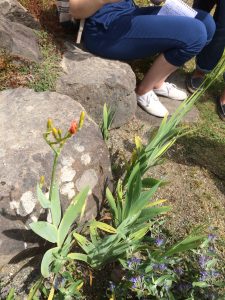
Common name: leopard lily
family name: Iridaceae
USDA Hardiness Zone: 5-10
Mature height and spread:
height: 2-3 f
spread: 0.75-2 f
Form: Clumps slowly expand by creeping rhizomes
Water use: like moist, poor-drained
Soil requirements: average, medium, well-drained soils in full sun
Flower/Cone/Fruit description: an erect, rhizomatous perennial which typically grows 2-3′ tall. Lily-like, deep orange flowers (to 2″ across), heavily spotted with red dots, have 6 petal-like perianth segments. Flowers appear in early to-mid summer in sprays above the foliage on wiry, naked stems typically rising to 3′ (less frequently to 4′) tall. Sword-shaped, iris-like, medium green leaves (to 10″ long) are in flattened fans. Flowers give way to pear-shaped seed pods which split open when ripe (late summer), with each pod revealing a blackberry-like seed cluster.
suitable uses:garden borders